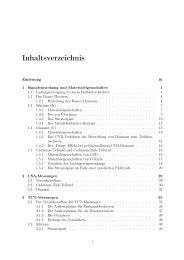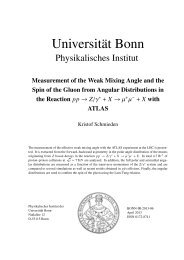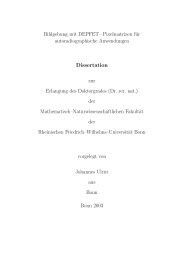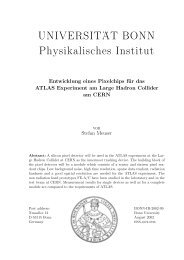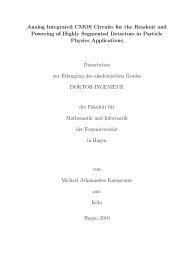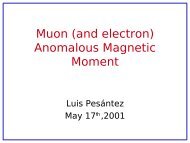Jens Janssen Diploma Thesis - Prof. Dr. Norbert Wermes ...
Jens Janssen Diploma Thesis - Prof. Dr. Norbert Wermes ...
Jens Janssen Diploma Thesis - Prof. Dr. Norbert Wermes ...
Create successful ePaper yourself
Turn your PDF publications into a flip-book with our unique Google optimized e-Paper software.
where C test is the capacitance equal to n · (C hi + C lo ) or n · C lo , f is the frequencyof the charging/discharging circuit, V CapMeas is the potential applied tothe CapMeas pad (usually 2V, diodes to DGND 3 and VDD) and I CapMeas isthe measured mean current. The multiplicity n and the charge/discharge frequencyf can be set by global register [67:64] and [69:67], respectively. Thenominal value for the low injection capacitance C lo is 8fFand for high injectioncapacitance (C hi + C lo )is40 fF.The measurement results of the test capacitor deviates by about 10% eachsuccessive measurement. Also an error in the capacitance over the entire FE-I3 readout chip has to be considered, though it is not possible to measure theabsolute values for each pixel.5.5 Tuning of the FE-I3Tuning of the FE-I3 means the calibration of the analog part of every readoutchannel on the FE-I3 readout chip. In other words, registers need to be adjustedin such a way that the preamplifier and discriminator of each pixel on the FE-I3readout chip operate in a limited range.The tuning starts with a standard setup as given in Appendix A. The standardtuning has a typical target threshold of 4000 e - and aims for a gain of60 bunch crossings 4 (BC) Time-over-Threshold 5 (ToT) at charge collection of20, 000 e - (colloquially referred to as “60 ToT at 20, 000 e - ”). The charge of20, 000 e - is to be expected for a minimum ionizing particle (MIP) passingthrough bulk silicon of 250 µm thickness.The standard tuning as described above is not su cient for lab characterization.The following points were changed compared to the standard tuning:1. The threshold was lowered to 3200 e - . Apart from the fact that this thresholdwas chosen for former laboratory measurements and was used duringtest beam, there are several reasons for choosing a lower threshold: first,the threshold can be lowered to that value because there is no influenceof large detector system on the electronics of the device under test (thisincludes e ects on noise and threshold dispersion). Second, for sensorcharacterization it is necessary to measure as much generated charge aspossible. The lower the threshold, the more pixels see a hit (increased hitprobability). In case of charge sharing between adjacent pixels the additionalmeasured charge can be assigned to the seed pixel (higher chargecollecting e ciency). Third, the threshold of 3200 e - is a compromise betweencharge collection e ciency and noise occupancy (also referred toas noise hit rate, see [8]). As shown in [34], in case of unirradiated 3Dsensors, noise occupancy starts rising significantly from a threshold of approximately3200 e - and lower on.3 DGND is connected to AGND if jumper SJ16 of the Single Chip Card is closed.4 The bunch crossing (BC) rate at LHC is 40 MHz and corresponds to a time of 25 ns.5 The discriminator asserts a hit signal if the signal from the second amplifier is over acertain threshold. The length of the hit signal is proportional to the amount of collectedcharge. The digital readout electronics generates a leading edge (LE) and trailing edge (TE)flag out of the hit signal. LE and TE are sent to the column arbitration unit (CAU) wherethe time between LE and TE is calculate by a 8-bit counter which is incremented every 25 ns(40 MHz). This time is called Time-over-Threshold (ToT) and is proportional to the collectedcharge.53



